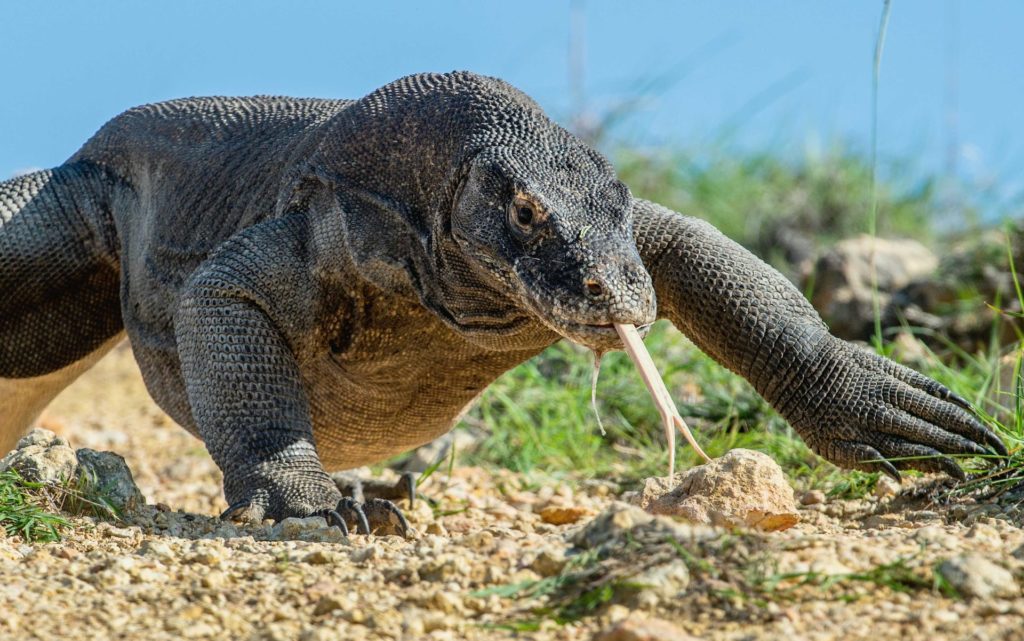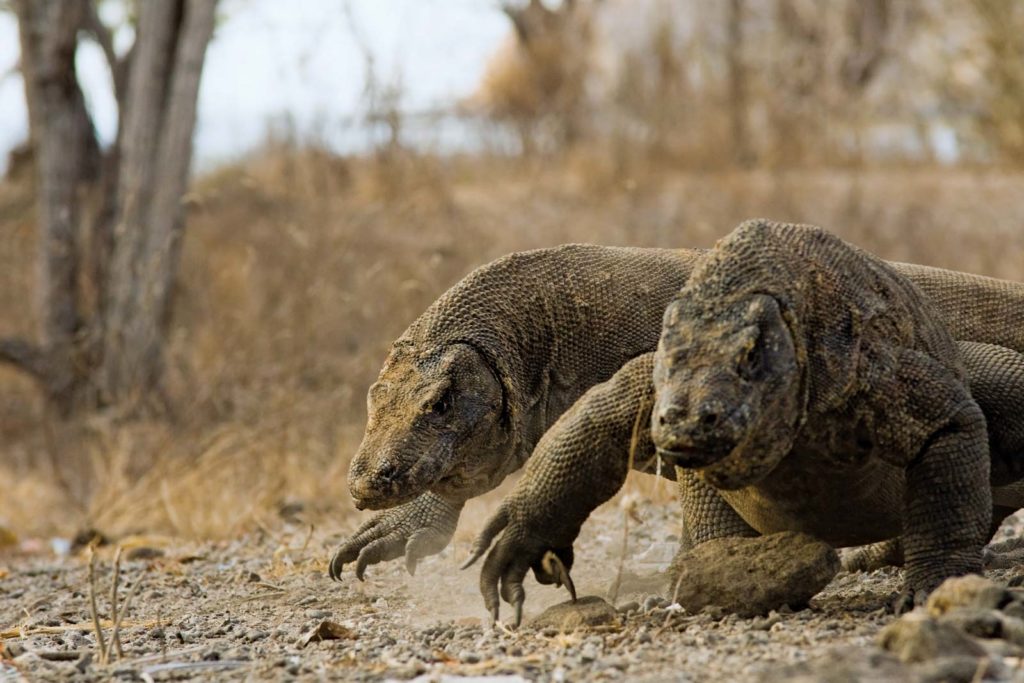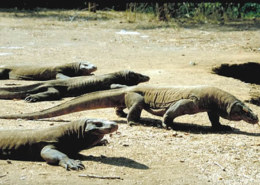What Are The Main Komodo Dragon Facts You Need To Know?
The largest living lizard in the world is the Komodo dragon. Hunted almost to extinction after Western scientists discovered the reptile on Komodo Island, Indonesia, in 1912, this species is currently protected under Indonesian law.This article gives insights about some important Komodo Dragon facts
The Komodo dragon is a monitor lizard of the family Varanidae and is therefore sometimes referred to as the Komodo monitor. The scientific name of the Komodo dragon is Varanus komodoensis.
Here Are Some Important Komodo Dragon Facts
The Komodo dragon (Varanus komodoensis) is a lizard species that is found on the islands (particularly the Komodo Island) in central Indonesia.
The komodo dragon is a member of the monitor lizard family and is the largest living species of lizard. Because of their size and because there are no other carnivorous animals, these apex predators dominate the ecosystem in which they live.

komodo dragon
Description
Komodo Dragons grow to an average length of 2 – 3 metres (6.5 – 10 feet) and weigh around 70 kilograms (154 pounds). Captive komodo dragons may often weigh more, as much as 166 kilograms (365 pounds).
Komodo dragons are the heaviest lizards on Earth. They have long, flat heads with rounded snouts, scaly skin, bowed legs and huge, muscular tails.

typical komodo dragons
They have about 60 frequently replaced serrated teeth that can measure up to 2.5 centimetres (1 inch) in length.
Their saliva is frequently tinged with blood, because their teeth are almost completely covered by gingival tissue that is naturally lacerated during feeding.
They also has a long, yellow, deeply-forked tongues.
Their tongue is used to detect taste and smell as in many other reptiles and they can detect carrion from 4 – 9.5 kilometres (2.5 – 6 miles) away.
Komodo Dragons have visible ears although they do not have acute sense of hearing. They are able to see as far as 300 metres (985 feet), however, they have poor night vision. The Komodo Dragon is also able to see in colour.
The komodo dragons nostrils are not very good for smelling and it only has a few taste buds at the back of its throat. Their scales, some of which are reinforced with bone, have sensory plaques connected to nerves that facilitate their sense of touch. The scales around the ears, lips, chin and soles of the feet may have three or more sensory plaques.
The imposing giant Komodo dragons reach a length of up to 10 feet (3 meters) and weigh approximately 300 pounds (135 kilograms). Females are generally smaller than males.
Komodo dragons have robust bodies and thick, muscular legs with feet that end in sharp claws. The head is flat, and the long snout is rounded. The large flexible jaw and muscled throat can expand to accommodate the large chunks of flesh that these animals gulp down.
The powerful jaws are equipped with about 60 razor-sharp, serrated teeth that are replaced quite often.
Komodo dragons are believed to have possibly influenced some ancient myths of fire-breathing dragons because of their yellow forked tongues and foul breath, which is caused by bacteria-infested saliva.
The scales covering the animals’ bodies are usually a dull, dark gray in color and are separated by a somewhat brighter-colored skin in between. The long tails are equal to the length of their bodies. The tails are powerful enough to knock a large mammal, such as a water buffalo, off of its feet with one swipe.
Habitat
The Komodo dragon prefers hot and dry places and typically lives in dry open grassland, savanna, scrubland and tropical forests at low elevations. Komodo dragons dig holes that can measure from 1 – 3 metres (3 – 10 feet) wide using their powerful forelimbs and claws.
Komodo dragons have a very small distribution and only inhabit specific islands in Indonesia. They are found on some of the Lesser Sunda Islands, including Komodo, Rinca, Gili Dasami, Gili Montang, and Flores. Komodo dragons roam throughout all areas of the islands but prefer the grassy savannas. They inhabit the forested regions and may patrol along their perimeter. The climate is warm and dry with very little water on the islands, except during a brief monsoon season each year.
Behavior
Komodo dragons are quadrupeds, meaning that they stand and walk on all four legs. Although these animals are quite large and heavy, they are remarkably agile climbers and can run with a surprising amount of speed. They are also capable swimmers and sometimes swim long distances between islands. Komodo dragons are solitary by nature.

behavior of komodo dragons
Komodo Dragons are mostly active during the day but have shown some nocturnal behaviour. They are solitary animals that only come together to breed and eat. They are quite fast creatures and can move rapidly in brief sprints up to 20 kilometres per hour (12.4 miles per hour). Young komodo dragons can climb trees easily with the use of their strong claws.
Because of their large size, Komodo Dragons are able to conserve body heat by sleeping in their burrows reducing their need to bask in the mornings. They typically hunt in the afternoons and stay in shaded areas during the hottest parts of the day.
Feeding
Komodo Dragons are carnivores and mainly feed up on carrion (dead animal carcasses). They also hunt and ambush prey such as invertebrates, mammals and birds. To catch prey that is out of reach, komodo dragons are able to stand on their hind legs and use their tails as support. They have also been known to use their tails to knock down large deer and pigs.
Komodo dragons eat by tearing large chunks of flesh and swallowing them whole while holding the carcass down with their forelegs. Because of their slow metabolism, large dragons can survive on as little as 12 meals a year. Because the Komodo dragon does not have a diaphragm, it cannot suck water when drinking, nor can it lap water with its tongue. Instead, it drinks by taking a mouthful of water, lifting its head, and letting the water run down its throat. A komodo dragon can eat a whopping 80 percent of its body weight in a single feeding.
Reproduction/Life Cycle
The Komodo Dragon breeding season occurs between May and August. Around 20 eggs are laid in September which are deposited in abandoned megapode nests (Megapode – stocky, medium-large chicken-like birds with small heads and large feet). Eggs are incubated for 7 – 8 months, hatching in April the following year when insects are abundant. The young dwell in trees for safety as they are very vulnerable to predators and cannibalistic adult dragons.
Komodo Dragons mature in about 3 – 5 years. Komodo Dragons are capable of parthenogenesis (par-the-no-gen-e-sis), a form of reproduction in which an unfertilised egg develops into a new individual, occurring commonly among insects and certain other arthropods. Young Komodos will eat insects, eggs, geckos and small mammals. Komodo dragons may be monogamous and form pair bonds, a rare behaviour for lizards.
Newly hatched Komodo dragons are about 16 inches (40 centimeters) in length and weigh approximately 3.5 ounces (100 grams). Their skin pattern is either speckled or banded and displays a variety of colors, including green, yellow, gray, and brown. No parental care is given to young Komodo dragons once they have hatched, and they quickly scramble up the nearest tree to avoid being eaten by the adults. The young spend their first year of life living in trees, where they feed upon insects. Once they have reached about 4 feet (1.2 meters) in length, they are large enough to defend themselves against predators and other adult Komodo dragons. They then climb back down to the ground, where they continue to mature. The life span of the komodo dragon is over 30 years.
Conservation Status
The Komodo Dragon is classed as ‘Vulnerable’ by the IUCN. Komodo Dragons are protected under Indonesian law, and a national park, Komodo National Park, was founded to aid protection efforts. In the wild their range has contracted due to human activities. The largest risk to the survival of the Komodo Dragon is encroachment by humans, destruction of environment and poaching of prey such as the Sunda deer. There are approximately 4,000 – 5,000 living Komodo dragons in the wild. Although attacks are very rare, Komodo dragons have been known to kill humans.
The numbers of Komodo dragons in Indonesia have plummeted because of hunting, mainly for their skins but also for zoo collections and for sport. The decline of a main prey animal—deer, which have been overhunted—as well as habitat loss for human development are other reasons for the reptile’s decline. Komodo dragons are also sometimes poisoned by local villagers who fear that these huge reptiles, which they call ora (“land crocodile”), may eat their children or livestock. Another cause of their decline includes disturbance by the growing amount of tourists who visit the islands specifically to see these giant living dragons—an activity that the government of Indonesia regulates. Biologists estimate that the maximum population of Komodo dragons at the beginning of the 21st century was approximately 5,700 individuals. The International Union for Conservation of Nature (IUCN) lists the Komodo dragon as vulnerable.
Credit:
https://kids.britannica.com/students/article/Komodo-dragon/328523



Leave an answer
You must login or register to add a new answer.